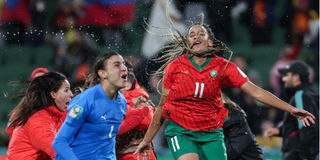World Cup has raised women's game to new level

Morocco's goalkeeper Khadija Er-Rmichi (left) and Fatima Tagnaout celebrate their team's victory and qualification to the knockout stage after the end of the Australia and New Zealand 2023 Women's World Cup Group H match against Colombia at Perth Rectangular Stadium in Perth on August 3, 2023.
What you need to know:
- The ongoing Women’s World Cup has certainly elevated the women’s game to a different level
- We are yet to enter the quarter-finals and records have already been broken in terms of attendance and TV audience numbers, far outstripping Fifa’s expectations
- After needing a fundraising campaign to even get on the plane, few, if any, expected Jamaica to become the first Caribbean team to hit the knockout stage since Cuba in 1938
Film maker John Koenig, in his book titled Dictionary of Obscure Sorrows, invents a new word – anemoia, to mean “a nostalgia for a time or place that one has never known.” I never knew the word existed until recently when I picked up the book, and it wasn’t until Monday this week that I felt this anemoia. The feeling was so profound it made my eyes moist.
In the match between Canada and Australia on Monday, I was rooting for underdogs Canada, and it was sad to see them exit the tournament after soaking in four goals with no reply. But, that’s not what brought the tears. Those came following a brief cutaway which came on the screen moments before half-time. The camera focused on the stands, where about eight Australian girls were seen climbing over each other, roaring and cheering, mad with excitement following Hayley Raso’s second goal. They were decked in Australia’s green-and-gold colours, their cheeks and foreheads painted in the same colours. None of them looked more than 10 years old.
It reminded me of the euphorias of my own girlhood that, sadly, never got to include going to the stadium, howling through a game of top-flight international professional women’s football or watching girls like me sweat it out on the pitch while playing “the men’s game”. Watching those girls, I felt a strange tightness in my chest, a deep longing for a past that was clearly their present. And it is at that moment that the word anemoia made all the sense in the world.
The ongoing Women’s World Cup has certainly elevated the women’s game to a different level. We are yet to enter the quarter-finals and records have already been broken in terms of attendance and TV audience numbers, far outstripping Fifa’s expectations. Unforgettable plotlines have been witnessed, heavyweights have been felled, and winning has taken a new meaning.
The United States women’s national team, top contenders for the title, were sent home at the knockout stage, triggering a series of ‘what went wrong’ analyses’. Brazil, ranked eighth in the world and boasting of Marta da Silva, a mythical forward who is considered the greatest female footballer of all time, certainly had higher expectations, but they flew home immediately after the group stage.
I’m certainly not the only one who expected Morocco to remain at the group stage in their debut world cup, yet they made history by moving to the knockouts! After needing a fundraising campaign to even get on the plane, few, if any, expected Jamaica to become the first Caribbean team to hit the knockout stage since Cuba in 1938. And, how can anyone forget Banyana Banyana. The South Africans weren’t expected to destroy Italy and go on to give Netherlands a run for their money, but they did. What about Germany, two-time World Cup champions? For the first time since anyone can remember, they failed to get to the knockout stage. What a gripping watch this World Cup has been so far!
It is a great joy to see the tournament capturing the imagination of girls around the world. Since the hands of time can never be turned back, older women like me will have to gladly embrace the anemoia, because it is wonderful to finally see our gender represented in such a lovely way.





